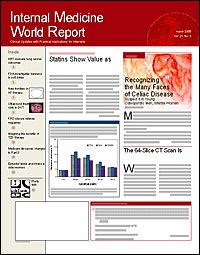Publication
Article
Internal Medicine World Report
Busting Blood Clots with Ultrasound
Author(s):
MIAMI BEACH?A simple device consisting of a few transducers the size of a grain of rice that are strung along a hair-thin wire can help dissolve blood clots in the legs and pelvis that, if left untreated, may lead to the loss of a limb or even a life. Thomas McNamara, MD, chief of vascular and interventional radiology, University of California, Los Angeles Medical Center, introduced the ultrasound-enhanced drug delivery system at the 18th annual International Sym?po?-?s?ium on Endovascular Therapy.
A study of 99 patients demonstrated that the device significantly reduced the time it takes to dissolve clots, and it also reduces the risk of major bleeding. It has been tested for the removal of clots responsible for peripheral artery oc?clusion and deep vein thrombosis (DVT) but may also be used to dissolve blood clots in the brain.
The current ap?proach to dissolving clots employs a cath?eter to deliver the thrombolytic agent to the clot. The new device also uses a catheter that carries a very thin wire, upon which anywhere from 6 to 30 tiny transducers are at?tached, located about 1 cm apart. The transducers emit high-frequency, low-energy ultrasound waves that temporarily loosen up the fiber and drive the drug throughout the clot (Figure).
Dr McNamara told IMWR that the ultrasound device enhances the work of the thrombolytic drug by opening the fi?brin matrix, the skeleton around which the clot forms, which is required for the stability of the clot. "It opens up the fiber matrix so that a thrombolytic agent can readily permeate through it, and it also pushes the thrombolytic agent through it, so the contact of the agent with the fibrin strands is more rapid," he said.
There are additional ways to dissolve clots, such as fragmentation, but this can cause portions of the clot to travel downstream, leading to embolization and worsening of ischemia, eventually resulting in limb loss. Thrombolysis can be accelerated by administering higher doses of thrombolytic agents or by combining them with a glycoprotein 2B3A inhibitor. However "all those pharmacologic measures increase bleeding, and the mechanical measures to increase the rapidity of thrombolysis are associated with em?bolization. This is a matter of enhancing or speeding thrombolysis without more bleeding," he said.
In about 25% of the procedures Dr McNamara has performed thus far, the clots have dissolved in approximately one third of the time that it used to take. "That makes treatment on the same day feasible. We now schedule patients to do this on an outpatient basis. That's on the arterial side. On the venous side, thrombolysis has usually been limited to patients with the worst possible conditions?clots extending from the navel to their ankles. Those pro?cedures usually require about 3 days. With this method of more rapidly enhancing the lysis, the duration has been cut to 24 hours."
While a mishap in the legs could result in the loss of a limb, a problem in the heart could lead to myocardial infarction or death, and a slip up in the brain could lead to stroke. Dr McNamara expects to see a natural progression; once the technology has been worked out and established in the peripheries, it will be applied to the coronary circulation and to treat strokes.
He encourages physicians to look at non??surgical methods, such as the ultra- sou?nd device, for treating arterial problems.
"Clotting is a tremendous source of disability and amputation. It is a remarkably undertreated portion of our anatomy, and ultrasound technique enhances the ability to achieve rapid and complete lysis and allows the valves to remain normal in patients with DVT. Patients don't have a long-term adverse sequela of the postphlebitic syndrome for which we have no good treatment. Prevention by the ultrasound device during the first month of treatment is the best treatment and is becoming easier to do," he said.
The ultrasound device has been ap??proved by the FDA for removing clots from peripheral arteries and veins and can be used by any physician. Currently 20 centers around the country are evaluating it in a registry format. It is also being studied for stroke in a National Institutes of Health multi?center trial.






